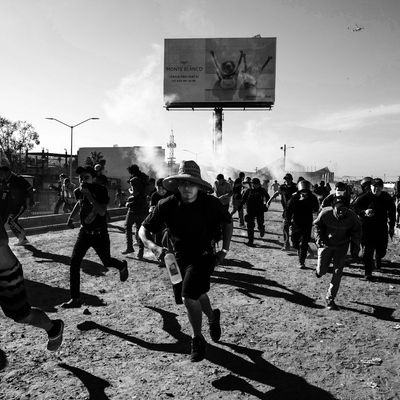
The U.S. temporarily closed its busiest port of entry along the Mexican border on Sunday after U.S. and Mexican authorities clashed with a group of migrants who were attempting to rush the border. The migrants were mostly Central Americans who had traveled thousands of miles to the U.S. border in a large migrant caravan — only to end up stuck in makeshift shelters in Tijuana, awaiting their opportunity to meet with U.S. border officials. Over the past few weeks, more than 5,000 asylum-seekers have arrived in Tijuana, and thousands more are on the way. The conditions and governmental reactions on both sides of the border, meanwhile, will only worsen.
How did the clash at the border on Sunday start?
Just after 10 a.m. on Sunday morning, hundreds of protesters from the caravans marched from their main camp at a sports complex in Tijuana to the San Ysidro crossing at the U.S.–Mexican border. They wanted to call attention to their worsening living conditions in Tijuana, and to hopefully have the opportunity to speak with a U.S. border official. Some of the protesters held handmade U.S. and Honduran flags, while others carried signs bearing friendly messages for President Trump. Some marchers chanted about how they were not criminals, as Trump and others have repeatedly sought to characterize them.
Ahead of the protests, U.S. Customs and Border Protection brought in extra officers on Sunday. (Last Thursday, a group of asylum-seekers from the caravan marched to the border, which took place without incident.)
What happened next?
When the marchers approached the border crossing at about 11:20 a.m., they encountered a blockade of Mexican police officers holding riot shields. Some migrants clashed with the police, while many others ran around them and rushed up and over embankment onto the almost dry concrete bed of the Tijuana River. One small group of migrants tried to make it to a nearby border crossing for trains, but they were stopped by tear gas fired by CBP officers, and the area was eventually cleared by Mexican police; another small group tried to tear through a border fence.
CBP officers used tear gas to push back migrants in other areas too, firing multiple canisters to clear the concrete banks of the Tijuana River. The agency later said that some migrants had thrown projectiles at officers, and claimed that was why the tear gas had been used. Eventually, the migrants retreated or were escorted back to their makeshift camps in Tijuana. More than two dozen tear gas canisters could be seen on the ground afterward.
On Monday, a U.S. Border Patrol official said that 42 people had been arrested, and that some asylum-seekers had been able to get past the border. No serious injuries have been confirmed on either side of the clash. Mexican officials claimed on Sunday that 39 migrants had been arrested and would be deported, as would roughly 500 others who the Mexican Interior Ministry said tried to “violently” and “illegally” cross the border.
Following reports that American authorities had deployed tear gas, organizations, border lawmakers, and celebrities condemned the inhumane violence. Mexico’s National Commission of Human Rights called the use of gas an “unnecessary risk,” and representative Beto O’Rourke, former Democratic candidate for Senate in Texas, called on America to “allow asylum seekers to petition for asylum at our ports of entry” and “address underlying conditions that are causing them to flee in the first place.”
“It should tell us something about her home country that a mother is willing to travel 2,000 miles with her 4-month-old son to come here,” he wrote on Medium. “Should tell us something about our country that we only respond to this desperate need once she is at our border. So far, in this administration, that response has included taking kids from their parents, locking them up in cages, and now tear gassing them at the border.”
What are the asylum-seekers fleeing?
The majority of the Central Americans are fleeing unlivable conditions brought on by climate change, economic insecurity, state violence, and organized criminal activity. While many of those seeking asylum have come from Honduras, others have traveled from Guatemala and El Salvador. The overarching motivation is desperation, which is why they seek asylum; they are not attempting to cross into the U.S. illegally.
Upon arriving at the border, asylum-seekers are facing hostility from both sides. Forced to live in makeshift refugee camps, they do not have an ally in the Trump-like mayor of Tijuana, Juan Manuel Gastélum, who has demonized the migrants with nativist rhetoric and threatened to expel them. Anti-migrant sentiment has been rising in the city of 1.6 million, and angry residents have staged tense demonstrations and clashes. As BuzzFeed News’ Karla Zabludovsky explained earlier this month, “The pushback against the caravan in Tijuana has brought long-standing racism toward Central Americans neighbors to the surface, highlighting the incongruous attitude of Mexicans who demand better treatment in the U.S. while discriminating against — and often victimizing — migrants who move north through the country.”
Who or what is responsible for the crisis?
Trump and his administration have been doing everything in their power to make it harder for the migrants to apply for asylum in the first place, which is one of the reasons there is a buildup. The president also engaged in racist fear mongering about the migrant caravan for weeks before the midterms, though this probably hurt the GOP at the polls more than it helped. The bluster seems to have worked on Mexico, however, as their overreaction has helped fuel the crisis.

